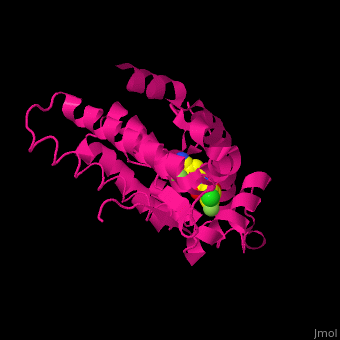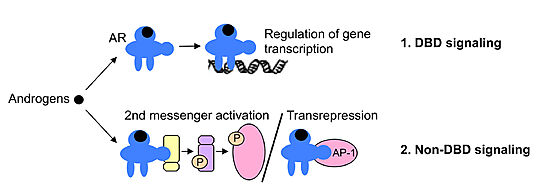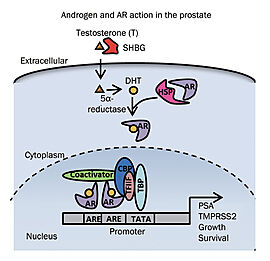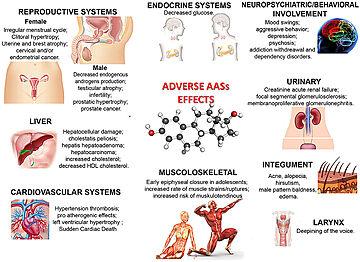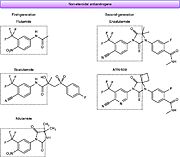Androgen receptor
From Proteopedia
(Difference between revisions)
| Line 13: | Line 13: | ||
===DNA-Binding Domain (DBD) (residues 555-623)=== | ===DNA-Binding Domain (DBD) (residues 555-623)=== | ||
DBD is a cysteine-rich region that is the most highly conserved one of the steroid hormone nuclear receptor family <ref name="Structure" />, but it has been shown that binding of selective androgen response elements (AREs) allow the specific activation functions of the AR. They facilitate direct DNA binding of the AR to the promoter and enhancer regions of AR-regulated genes, thereby allowing the activation functions of the N-terminal and ligand binding domains to stimulate or repress the transcription of these genes <ref name="Bench to Bedside" />. | DBD is a cysteine-rich region that is the most highly conserved one of the steroid hormone nuclear receptor family <ref name="Structure" />, but it has been shown that binding of selective androgen response elements (AREs) allow the specific activation functions of the AR. They facilitate direct DNA binding of the AR to the promoter and enhancer regions of AR-regulated genes, thereby allowing the activation functions of the N-terminal and ligand binding domains to stimulate or repress the transcription of these genes <ref name="Bench to Bedside" />. | ||
| - | AR is a dimer, like other steroid receptors, that binds to promoter DNA response elements consisting of two equal, common hexameric half-sites, separated by a 3 base-pair spacer <ref name="Structure" /> | + | AR is a dimer, like other steroid receptors, that binds to promoter DNA response elements consisting of two equal, common hexameric half-sites, separated by a 3 base-pair spacer <ref name="Structure" />, and this domain is critical for AR function, because it plays a role in dimerization and binding of dimerized AR to select motifs on target DNA <ref name="AR" />. |
Each DBD monomer has a core composed of two zinc finger motifs, which consists of four cysteine residues that coordinate a zinc ion <ref name="Structure" />. The first is closer to the NTD which has the P box, which is identical in all the family, and controls the DNA binding specificity at AREs, located in the regulatory regions of genes <ref name="AR" />. | Each DBD monomer has a core composed of two zinc finger motifs, which consists of four cysteine residues that coordinate a zinc ion <ref name="Structure" />. The first is closer to the NTD which has the P box, which is identical in all the family, and controls the DNA binding specificity at AREs, located in the regulatory regions of genes <ref name="AR" />. | ||
The second zinc finger motif facilitates AR dimerization via the D box. Additionally, a nuclear localization signal (NLS) is localized at the junction between the DBD and the hinge region and it binds to importin-α and facilitates nuclear translocation <ref name="AR" />. This is because passive transport across the nuclear pore complex has been suggested ranging from 20–40 kDa, in contrast, the AR, which is 110 kDa in size, requires help to be actively transported upon ligand binding <ref name="Structure" />. | The second zinc finger motif facilitates AR dimerization via the D box. Additionally, a nuclear localization signal (NLS) is localized at the junction between the DBD and the hinge region and it binds to importin-α and facilitates nuclear translocation <ref name="AR" />. This is because passive transport across the nuclear pore complex has been suggested ranging from 20–40 kDa, in contrast, the AR, which is 110 kDa in size, requires help to be actively transported upon ligand binding <ref name="Structure" />. | ||
| Line 36: | Line 36: | ||
'''[[Image:Translocation.jpg | thumb | upright=1.5]]''' | '''[[Image:Translocation.jpg | thumb | upright=1.5]]''' | ||
In the absence of ligand, the AR is in the cytoplasm and associated with heat-shock and other chaperone proteins. Testosterone is converted into DHT by 5α-reductase, with higher affinity to bind AR. When DHT binds AR, it displaces heat shock proteins, drives the interaction between the N and C terminal, and binds importin-α to translocate the ligand/AR complex into the nucleus. | In the absence of ligand, the AR is in the cytoplasm and associated with heat-shock and other chaperone proteins. Testosterone is converted into DHT by 5α-reductase, with higher affinity to bind AR. When DHT binds AR, it displaces heat shock proteins, drives the interaction between the N and C terminal, and binds importin-α to translocate the ligand/AR complex into the nucleus. | ||
| - | In the nucleus, the receptor dimerizes and binds to AREs in the promoter regions of target genes. At the promoter, the AR is able to recruit members of the basal transcription machinery in addition to other coregulators to facilitate transcription <ref name="Structure" />. AR activity is not only regulated by ligand binding and DNA binding but also by intramolecular interactions between functional domains, by homodimerization and by interactions with cofactors | + | In the nucleus, the receptor dimerizes and binds to AREs in the promoter regions of target genes. At the promoter, the AR is able to recruit members of the basal transcription machinery in addition to other coregulators to facilitate transcription <ref name="Structure" />. AR activity is not only regulated by ligand binding and DNA binding but also by intramolecular interactions between functional domains, by homodimerization and by interactions with cofactors <ref>PMID: 22328501</ref>. |
This leads to the initiation of transcription, cell proliferation and survival, and negative feedback to inactivate AR transcription <ref name="Bench to Bedside" />. | This leads to the initiation of transcription, cell proliferation and survival, and negative feedback to inactivate AR transcription <ref name="Bench to Bedside" />. | ||
Revision as of 10:30, 28 November 2022
| |||||||||||
References
- ↑ 1.0 1.1 1.2 1.3 1.4 1.5 1.6 1.7 1.8 1.9 Davey RA, Grossmann M. Androgen Receptor Structure, Function and Biology: From Bench to Bedside. Clin Biochem Rev. 2016 Feb;37(1):3-15. PMID:27057074
- ↑ Kolyvas EA, Caldas C, Kelly K, Ahmad SS. Androgen receptor function and targeted therapeutics across breast cancer subtypes. Breast Cancer Res. 2022 Nov 14;24(1):79. doi: 10.1186/s13058-022-01574-4. PMID:36376977 doi:http://dx.doi.org/10.1186/s13058-022-01574-4
- ↑ 3.0 3.1 3.2 3.3 3.4 3.5 3.6 3.7 3.8 3.9 Tan MH, Li J, Xu HE, Melcher K, Yong EL. Androgen receptor: structure, role in prostate cancer and drug discovery. Acta Pharmacol Sin. 2015 Jan;36(1):3-23. doi: 10.1038/aps.2014.18. Epub 2014 Jun , 9. PMID:24909511 doi:http://dx.doi.org/10.1038/aps.2014.18
- ↑ 4.0 4.1 4.2 4.3 4.4 4.5 4.6 4.7 Messner EA, Steele TM, Tsamouri MM, Hejazi N, Gao AC, Mudryj M, Ghosh PM. The Androgen Receptor in Prostate Cancer: Effect of Structure, Ligands and Spliced Variants on Therapy. Biomedicines. 2020 Oct 15;8(10):422. doi: 10.3390/biomedicines8100422. PMID:33076388 doi:http://dx.doi.org/10.3390/biomedicines8100422
- ↑ van Royen ME, van Cappellen WA, de Vos C, Houtsmuller AB, Trapman J. Stepwise androgen receptor dimerization. J Cell Sci. 2012 Apr 15;125(Pt 8):1970-9. doi: 10.1242/jcs.096792. Epub 2012 Feb , 10. PMID:22328501 doi:http://dx.doi.org/10.1242/jcs.096792
- ↑ Kono M, Fujii T, Lim B, Karuturi MS, Tripathy D, Ueno NT. Androgen Receptor Function and Androgen Receptor-Targeted Therapies in Breast Cancer: A Review. JAMA Oncol. 2017 Sep 1;3(9):1266-1273. doi: 10.1001/jamaoncol.2016.4975. PMID:28301631 doi:http://dx.doi.org/10.1001/jamaoncol.2016.4975
- ↑ 7.0 7.1 7.2 Gibson DA, Saunders PTK, McEwan IJ. Androgens and androgen receptor: Above and beyond. Mol Cell Endocrinol. 2018 Apr 15;465:1-3. doi: 10.1016/j.mce.2018.02.013. Epub , 2018 Feb 24. PMID:29481861 doi:http://dx.doi.org/10.1016/j.mce.2018.02.013
- ↑ Ceruti JM, Leiros GJ, Balana ME. Androgens and androgen receptor action in skin and hair follicles. Mol Cell Endocrinol. 2018 Apr 15;465:122-133. doi: 10.1016/j.mce.2017.09.009. , Epub 2017 Sep 12. PMID:28912032 doi:http://dx.doi.org/10.1016/j.mce.2017.09.009
- ↑ 9.0 9.1 9.2 9.3 9.4 9.5 9.6 Solomon ZJ, Mirabal JR, Mazur DJ, Kohn TP, Lipshultz LI, Pastuszak AW. Selective Androgen Receptor Modulators: Current Knowledge and Clinical Applications. Sex Med Rev. 2019 Jan;7(1):84-94. doi: 10.1016/j.sxmr.2018.09.006. Epub 2018 Nov , 30. PMID:30503797 doi:http://dx.doi.org/10.1016/j.sxmr.2018.09.006
- ↑ 10.0 10.1 10.2 10.3 10.4 10.5 10.6 10.7 Burris TP, Solt LA, Wang Y, Crumbley C, Banerjee S, Griffett K, Lundasen T, Hughes T, Kojetin DJ. Nuclear receptors and their selective pharmacologic modulators. Pharmacol Rev. 2013 Mar 1;65(2):710-78. doi: 10.1124/pr.112.006833. Print 2013 , Apr. PMID:23457206 doi:http://dx.doi.org/10.1124/pr.112.006833
- ↑ 11.0 11.1 11.2 11.3 11.4 11.5 11.6 11.7 Christiansen AR, Lipshultz LI, Hotaling JM, Pastuszak AW. Selective androgen receptor modulators: the future of androgen therapy? Transl Androl Urol. 2020 Mar;9(Suppl 2):S135-S148. doi: 10.21037/tau.2019.11.02. PMID:32257854 doi:http://dx.doi.org/10.21037/tau.2019.11.02
- ↑ 12.0 12.1 12.2 12.3 Narayanan R, Coss CC, Dalton JT. Development of selective androgen receptor modulators (SARMs). Mol Cell Endocrinol. 2018 Apr 15;465:134-142. doi: 10.1016/j.mce.2017.06.013. , Epub 2017 Jun 15. PMID:28624515 doi:http://dx.doi.org/10.1016/j.mce.2017.06.013
- ↑ Culig Z, Klocker H, Bartsch G, Hobisch A. Androgen receptors in prostate cancer. Endocr Relat Cancer. 2002 Sep;9(3):155-70. doi: 10.1677/erc.0.0090155. PMID:12237244 doi:http://dx.doi.org/10.1677/erc.0.0090155
- ↑ 14.00 14.01 14.02 14.03 14.04 14.05 14.06 14.07 14.08 14.09 14.10 14.11 14.12 14.13 14.14 14.15 14.16 14.17 Helsen C, Van den Broeck T, Voet A, Prekovic S, Van Poppel H, Joniau S, Claessens F. Androgen receptor antagonists for prostate cancer therapy. Endocr Relat Cancer. 2014 Aug;21(4):T105-18. doi: 10.1530/ERC-13-0545. Epub 2014 , Mar 17. PMID:24639562 doi:http://dx.doi.org/10.1530/ERC-13-0545
- ↑ 15.0 15.1 15.2 15.3 15.4 15.5 Sesti F, Pofi R, Minnetti M, Tenuta M, Gianfrilli D, Isidori AM. Late-onset hypogonadism: Reductio ad absurdum of the cardiovascular risk-benefit of testosterone replacement therapy. Andrology. 2020 Nov;8(6):1614-1627. doi: 10.1111/andr.12876. Epub 2020 Aug 11. PMID:32737921 doi:http://dx.doi.org/10.1111/andr.12876
- ↑ 16.0 16.1 16.2 16.3 16.4 Kaur H, Werstuck GH. The Effect of Testosterone on Cardiovascular Disease and Cardiovascular Risk Factors in Men: A Review of Clinical and Preclinical Data. CJC Open. 2021 May 17;3(10):1238-1248. doi: 10.1016/j.cjco.2021.05.007. , eCollection 2021 Oct. PMID:34888506 doi:http://dx.doi.org/10.1016/j.cjco.2021.05.007
- ↑ 17.0 17.1 17.2 17.3 17.4 17.5 17.6 Bohl CE, Gao W, Miller DD, Bell CE, Dalton JT. Structural basis for antagonism and resistance of bicalutamide in prostate cancer. Proc Natl Acad Sci U S A. 2005 Apr 26;102(17):6201-6. Epub 2005 Apr 15. PMID:15833816
- ↑ 18.0 18.1 18.2 18.3 18.4 Gao W, Kim J, Dalton JT. Pharmacokinetics and pharmacodynamics of nonsteroidal androgen receptor ligands. Pharm Res. 2006 Aug;23(8):1641-58. doi: 10.1007/s11095-006-9024-3. PMID:16841196 doi:http://dx.doi.org/10.1007/s11095-006-9024-3
- ↑ 19.0 19.1 19.2 19.3 19.4 19.5 19.6 19.7 Machek SB, Cardaci TD, Wilburn DT, Willoughby DS. Considerations, possible contraindications, and potential mechanisms for deleterious effect in recreational and athletic use of selective androgen receptor modulators (SARMs) in lieu of anabolic androgenic steroids: A narrative review. Steroids. 2020 Dec;164:108753. doi: 10.1016/j.steroids.2020.108753. Epub 2020 Oct , 24. PMID:33148520 doi:http://dx.doi.org/10.1016/j.steroids.2020.108753
- ↑ 20.0 20.1 Fonseca GWPD, Dworatzek E, Ebner N, Von Haehling S. Selective androgen receptor modulators (SARMs) as pharmacological treatment for muscle wasting in ongoing clinical trials. Expert Opin Investig Drugs. 2020 Aug;29(8):881-891. doi: , 10.1080/13543784.2020.1777275. Epub 2020 Jun 18. PMID:32476495 doi:http://dx.doi.org/10.1080/13543784.2020.1777275
- ↑ 21.0 21.1 21.2 Masiello D, Cheng S, Bubley GJ, Lu ML, Balk SP. Bicalutamide functions as an androgen receptor antagonist by assembly of a transcriptionally inactive receptor. J Biol Chem. 2002 Jul 19;277(29):26321-6. doi: 10.1074/jbc.M203310200. Epub 2002 , May 15. PMID:12015321 doi:http://dx.doi.org/10.1074/jbc.M203310200
- ↑ 22.0 22.1 Duke CB, Jones A, Bohl CE, Dalton JT, Miller DD. Unexpected Binding Orientation of Bulky-B-Ring Anti-Androgens and Implications for Future Drug Targets. J Med Chem. 2011 Apr 20. PMID:21506597 doi:10.1021/jm2000097
- ↑ 23.0 23.1 23.2 23.3 Fujita K, Nonomura N. Role of Androgen Receptor in Prostate Cancer: A Review. World J Mens Health. 2019 Sep;37(3):288-295. doi: 10.5534/wjmh.180040. Epub 2018 , Sep 10. PMID:30209899 doi:http://dx.doi.org/10.5534/wjmh.180040
- ↑ 24.0 24.1 Leone G, Tucci M, Buttigliero C, Zichi C, Pignataro D, Bironzo P, Vignani F, Scagliotti GV, Di Maio M. Antiandrogen withdrawal syndrome (AAWS) in the treatment of patients with prostate cancer. Endocr Relat Cancer. 2018 Jan;25(1):R1-R9. doi: 10.1530/ERC-17-0355. Epub 2017 , Sep 28. PMID:28971898 doi:http://dx.doi.org/10.1530/ERC-17-0355
- ↑ 25.0 25.1 25.2 25.3 25.4 25.5 25.6 25.7 25.8 25.9 Cavaliere F, Cozzini P. An insight about the mechanism of action (MoA) of R-bicalutamide on the androgen receptor homodimer using molecular dynamic. Toxicol Appl Pharmacol. 2022 Apr 1;440:115953. doi: 10.1016/j.taap.2022.115953. , Epub 2022 Mar 1. PMID:35245614 doi:http://dx.doi.org/10.1016/j.taap.2022.115953
- ↑ Smith MR, Saad F, Chowdhury S, Oudard S, Hadaschik BA, Graff JN, Olmos D, Mainwaring PN, Lee JY, Uemura H, Lopez-Gitlitz A, Trudel GC, Espina BM, Shu Y, Park YC, Rackoff WR, Yu MK, Small EJ. Apalutamide Treatment and Metastasis-free Survival in Prostate Cancer. N Engl J Med. 2018 Apr 12;378(15):1408-1418. doi: 10.1056/NEJMoa1715546. Epub , 2018 Feb 8. PMID:29420164 doi:http://dx.doi.org/10.1056/NEJMoa1715546
- ↑ Pollock Y, Smith MR, Saad F, Chowdhury S, Oudard S, Hadaschik B, Olmos D, Lee JY, Uemura H, Bhaumik A, Londhe A, Rooney B, Brookman-May SD, De Porre P, Mundle SD, Small EJ. Clinical characteristics associated with falls in patients with non-metastatic castration-resistant prostate cancer treated with apalutamide. Prostate Cancer Prostatic Dis. 2022 Oct 8. doi: 10.1038/s41391-022-00592-9. PMID:36209239 doi:http://dx.doi.org/10.1038/s41391-022-00592-9
Proteopedia Page Contributors and Editors (what is this?)
Cristina Benito, Michal Harel, Cristina Murga, Marta Roldan Lazaro, Alexander Berchansky, Joel L. Sussman, Wayne Decatur, David Sánchez Fernández
